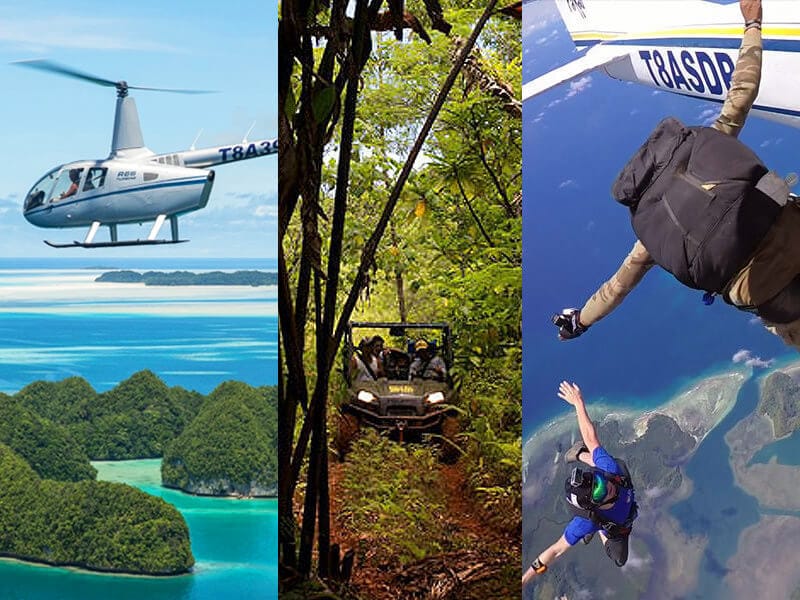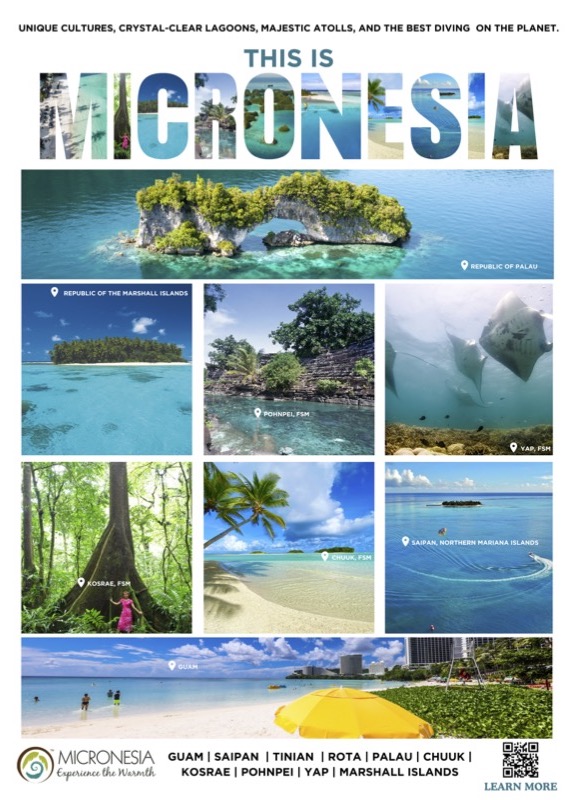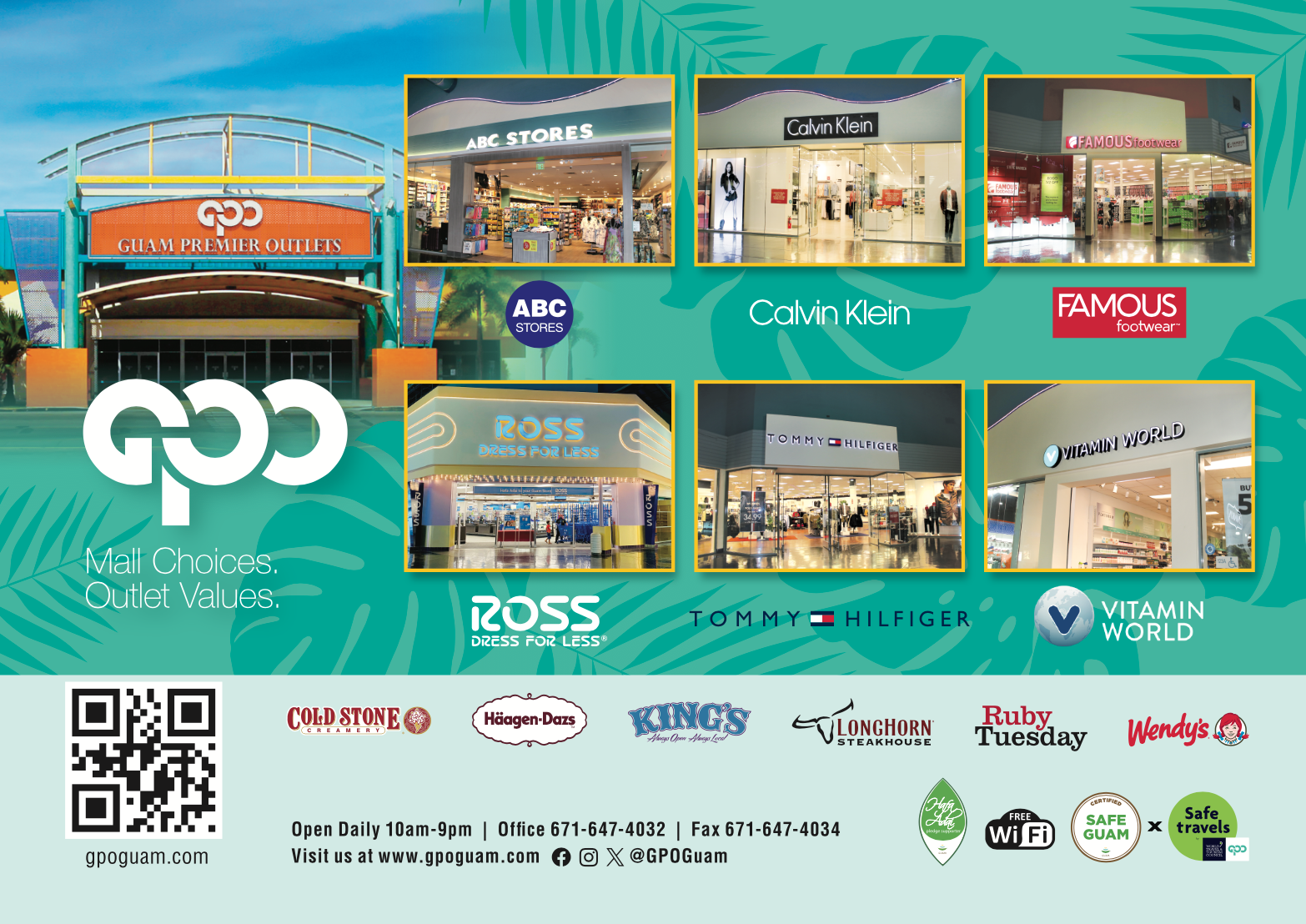PALAU HELICOPTERS INC.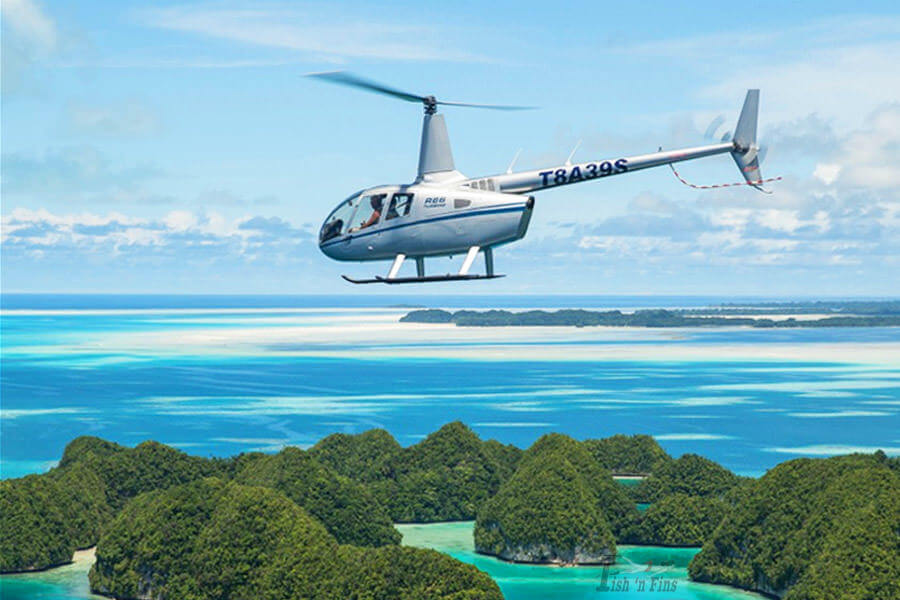
Vast swathes of Palau are entirely untouched and uninhabited, and as such, the best way to explore its lush landscapes is often by helicopter.
Explore Palau in a 2012 Robinson R66 Turbine Helicopter with Palau Helicopters Inc, just one of the extreme adventures provided by Fish ‘N Fins.
The craft, owned and operated by Palau Helicopters Inc., is brand new, and flown by an experienced pilot with many, many years of escorting Palau’s visitors over the islands.
Passengers can take in the pristine landscapes of the Rock Islands from above, with the helicopter’s Bubble Windows and panoramic glass offering the very best visibility for both those seated in the front and those in the back.
Take a bird’s eye view of the world-renowned Jellyfish Lake, the WWII battlefields of Peleliu, and Palau’s rainforests, waterfalls and dive sites. And bring home breathtaking photos. (Scenic flights and photography tours for exactly this purpose are available.) Passengers are welcome to take photos with or without open doors.
The Robinson R66 Turbine Helicopter
The Robinson R66 Turbine Helicopter was designed and built in the United States, using 21st century technology and adhering to all USA federal Aviation Administration Maintenance programme guidelines and regulations.
The helicopter’s lightweight structure and powerful Turbine Jet engine allow it to carry all the latest equipment, whilst flying higher, faster and further than other helicopters in its class. The R66 also has a great safety record, meeting the highest level of safety standards.
The craft is luxurious too. Passengers enjoy first-class leather seats, comfortable leg room, and extra personal space and shoulder room. Two-way communication is possible between passengers and pilot, though flyers also benefit from Bose® aviation-grade noise-cancelling headsets.
The Robinson R66 Turbine Helicopter was the bestselling helicopter in its year of release.
Palau’s International Airport
The Palau Helicopters Inc. craft is kept at Palau’s International Airport. Visitors can find the helicopter in a commercial hangar, and benefit from the modern office and air-conditioned waiting area.
Palau Helicopters Inc.
Palau Helicopters Inc. is the leading aviation service in Palau. It is currently working with Search & Rescue and Medevac programmes and local government on projects to ensure a safer diving and boating environment.
The tours
There are some spots in Palau that simply cannot be reached without a helicopter. This is where the R66 comes in.
Choose from a pre-set trip or design your own unique itinerary.
Scenic flights & tours
30-Minute Rock Island Tour
Prices: $1,400.00 ($350.00/person)
Visit: Ngeremdiu, Milky Way, Long Lake, Jellyfish Lake, the Arch, Pinchers, Koror, Japan-Palau Friendship Bridge
45-Minute Rock Island Tour
Prices: $1,800.00 ($450.00/person)
Visit: Ngeremdiu, Milky Way, Long Lake, Jellyfish Lake, 70 Islands, the Arch Pinchers, Koror, Japan-Palau Friendship Bridge
60-Minute Rock Island Tour
Prices: $2,200.00 ($550/person)
Visit: Ngeremdiu, Milky Way, Long Lake, 70 Islands, Blue Corner, Peliliu (Optional), Jellyfish Lake, the Arch, Pinchers, Koror, Japan-Palau Friendship Bridge
60 minutes with doors on: $2,200.00
60 minutes with doors off: $2,200.00 + $80 per door
Ground waiting (per hour): $400
Special trips
For more information about special trips, you can contact Palau Helicopters Inc. on 488-2637 or by email at info@palauhelicopters.com.
Set lunches and BBQs can also be booked in advance.
Kayangel Tour
Price: $3,400.00, incl. one-hour waiting
Visit: Kayangel, Palau’s only Atoll. Land at the Western Pier, and go for a swim or tour of the beaches with a guide. Fly back over Palau’s rainforest and waterfalls, and see the Palauan capital of Melekeok.
Rock Island Swim
Prices: (contact the office)
Visit: The Rock Islands. Land on the beach and enjoy a swim or walk on the deserted sands.
Waterfalls and rainforest
A helicopter tour is the ideal way to explore Palau’s breathtaking waterfalls and lush rainforest. Some of these pristine landscapes are inaccessible by road or boat, and a bird’s eye view is simply astonishing.
Ngaremlengui waterfalls
Price: $2,400.00, incl. one-hour waiting
Visit: Ngaremlengui waterfalls. This incredibly beautiful site is accessible only by helicopter. Swim in the clear waters and savour the tranquillity and isolation.
Ngardmau’s cascades
Price: $2,500.00, incl. one-hour waiting
Visit: Ngardmau’s cascades. West of the popular Ngradmau’s waterfalls, these extensive cascades are a long way from the road and accessible only by air.
Peleliu WWII visit
Price: $2,700.00, incl. one-hour waiting. (Optional land tour.)
Visit: Fly to Peleliu for an aerial tour of the historic battlefield. The dense vegetation prevents a full ground tour, with various relics and caves only visible from the sky. Stunning views of the crocodiles in the swamp and Peleliu’s various reefs and dive sites. Passengers have the option of landing at Peleliu’s WWII airstrip or the village north dock. A WWII expert is available for a land tour and visit to historic WWII sites.
Angaur WWII visit
Price: $3,100.00, incl. one-hour waiting. (Optional land tour.)
Visit: Fly to Angaur, and enjoy an aerial tour of the island and its WWII battlefields. The dense vegetation on the ground makes an air tour the only way to view the island’s relics. The island is also home to Palau’s colony of Macaque monkeys. On return, passengers can enjoy a bird’s eye view of Angaur’s reefs and dive sites; and have the option of landing at Angaur’s WWII airstrip or at the village’s dock. A local guide is available for a land tour of the historic WWII sites.
Big Animal Tour
Prices: (contact the office)
Visit: View some of the abundant marine life to which Palau is home. Sharks, turtles, dugong, manta rays, dolphins and whales are all commonly seen in the crystal clear waters. It can also be fun to fly over the dive spots and spot the divers enjoying the waters below.
Custom-made tours
Prices: (contact the office)
Visit: Design your own tour. Palau is an astonishingly beautiful landscape, and passengers can enjoy aerial views of its vistas, mountains, rainforests and waterfalls from the helicopter. Guides are available for various land tours, and there are countless deserted beaches and other beauty spots for swimming, diving, fishing, paddle boarding and kayaking. Many of the locations are seldom visited by other people, and all are ideal for photos and videos you will treasure for the rest of your life.
Production support and commercial work
The powerful Robinson R66 Turbine Helicopter is ideal for a range of aerial productions. Contact Palau Helicopters Inc. for details of its various services. These include film and video production support, advertising productions, aerial surveillance and geological survey.
The helicopter’s pilot, Martin Pacheco, is available for all types of commercial work. A highly experienced professional, he is happy to discuss under belly hook lifts, crop dusting, surveillance work and movie Productions.
Palau Helicopter Inc. tours are provided by Fish ‘N Fins.
OFF ROAD JUNGLE TOURS
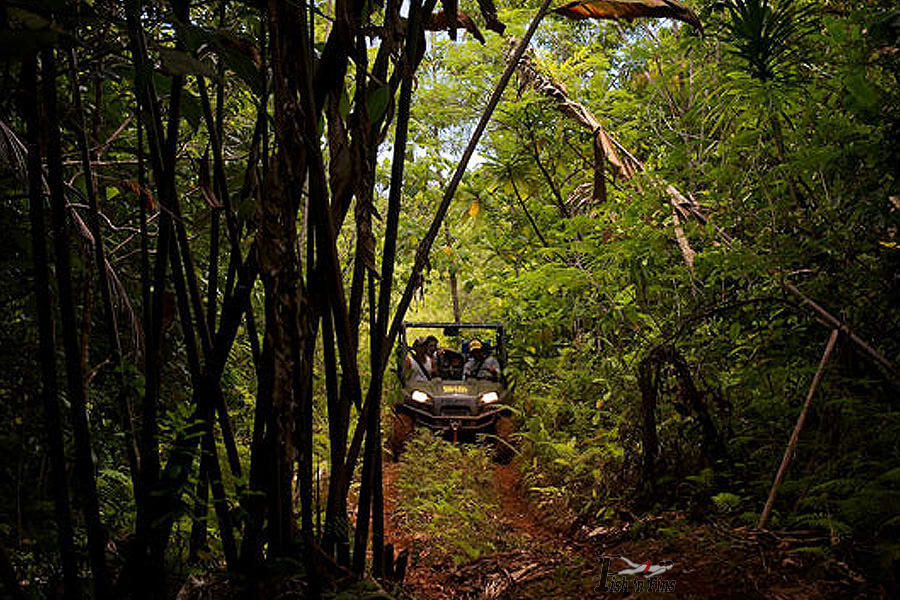
‘You drive, we guide.’
Palau is a small island-nation of astonishing beauty. Its pristine landscapes, lush rainforest, and unique culture attract in the region of 160,000 visitors per year.
But as expected of such a richly undisturbed paradise, transportation can be tricky. The road network does not give access to much of the rainforest, and much of the vegetation is incredibly dense.
Palau’s biggest island, Babeldaob, located to the northeast of Koror, is one of the most undeveloped of the populated islands in the Pacific. It is also incredibly beautiful and a real draw for visitors.
Off Road Jungle Tours from Fish ‘N Fins offer a solution.
Extreme 4WD expeditions
Visitors can explore the waterfalls, WWII relics, abandoned old villages rivers, and rainforests of Babeldaob with the Off Road Jungle Tours Polaris RZR 900 EFI: the world’s bestselling side by side ATV.
You can arrange custom tours of Ngatpang waterfalls, Palau’s capitol, Stone Monolith Overnight Camping, Peleliu and Angaur. Some combine tours of the historic WWII sites with other exploration. Half-day and full-day tours are all available.
A two-hour city tour can take visitors along hamlet dirt roads up to the top of Rock Island, for a stunning view of the bay.
This semi-military vehicle is designed for extreme terrain, offering all-wheel drive, four-wheel hydraulic disc brakes, and a four-stroke twin cylinder 900 cc EFI engine. With unbelievable power and refined ergonomics, it is ideal for Palau’s dirt roads and rainforest trails.
Your off-road route
Visitors might choose between some of the following day trips…
A Full Day in Ngardmau
Start at KB Bridge † along the rainforest trail † up to old Melekeok † along the Ngardmau dirt road † to Ngardmau Falls / Hunter Falls † Ngardmau Dock † enjoy Palau’s highest mountain view of Babeldaob.
A Full Day in Airai
Start at KB Bridge † from the CB camp onto the old road and up to Airai falls † see the WWII American tank † visit the Oykull New Dock † savour the panoramic views from Airai’s largest hill à head into Oykull village † visit the Oykull Old Dock
A Half-Day in Airai
Start at KB Bridge † visit the Oykull New Dock † climb Airai’s highest hill for a 360-degree view of the landscape † head to Oykull village † visit the Oykuul Old Dock
Malakal harbor
Start at KB Bridge † head to Malakal Harbour † climb Malakal’s highest hill for a 360 panoramic view † take a drive through the hamlets † visit the Ngermid Dock † finish at KB Bridge
Please note…
An international driving licence is required. All drivers must be at least 21 years of age, though participants of all ages are welcome. The vehicles accommodate a maximum of four people.
Off Road Jungle Tours are provided by Fish ‘N Fins.
SKY DIVE PALAU
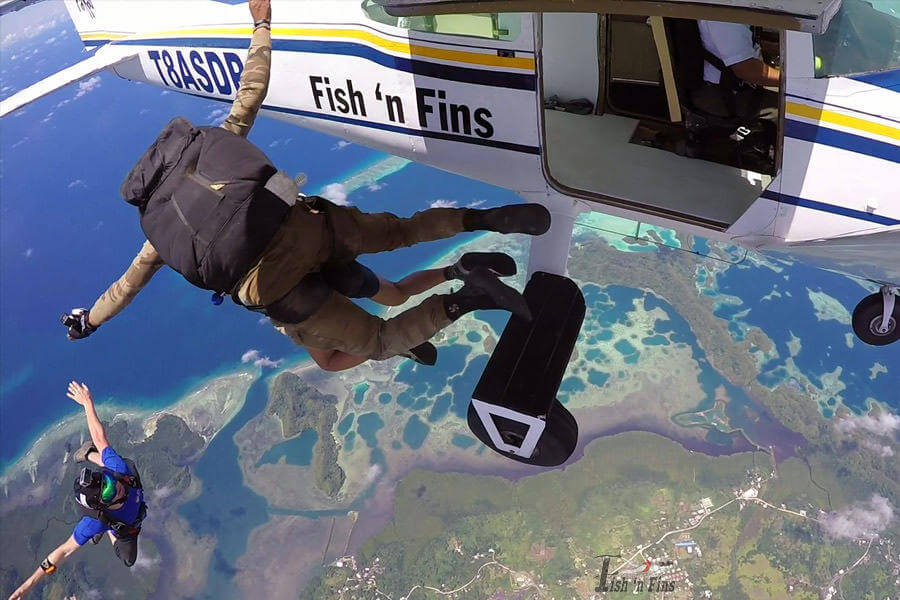
For the ultimate in extreme sports, surely nothing could beat tandem skydiving.
Sky Dive Palau, provided by Fish ‘N Fins, takes thrill-seekers on the adventure of a lifetime, with tandem skydiving jumps above the famous Rock Islands.
Free-falling through the sky, above Palau’s tropical landscapes, turquoise waters and white sandy beaches is nothing short of truly unforgettable.
Experienced and safety-oriented instructors
All Sky Dive Palau instructors are trained, experienced and fully qualified, and safety is their first, second and third priority!
Your Tandem instructor remains with you throughout the whole skydiving experience. They are beside you during the briefing on the ground. They observe the views with you as you make your way to altitude. You are together during the 40-60 seconds of free fall… and they are still right there when they safely land you at the Drop Zone at Palau International Airport.
Jumps can be from 10,000, 12,000 or even 14,000 ft, according to your preference.
The photos and videos of your jump will surely be mementos you treasure for the rest of your life.
Palau’s 2nd Boogie
Rich Grimm and Navot Bornovski organised the first ever boogie in Palau in 2014, and it was a roaring success. Participants enjoyed a week of scuba diving from luxurious liveaboards, the Oceanhunter I and Ocean Hunter III; and then five days of skydiving from Cessna 182, Cessna 206, and Robinson R66 helicopters onto island beaches and into historic WWII battlefields.
The event was such a success, it is happening again in 2018.
Both fun jumpers and experienced skydivers are more than welcome. A USPA ‘B’ licence (or similar water training licence) and a minimum of 100 jumps is required for solo skydivers.
Sky Dive Palau adventures are provided by Fish ‘N Fins.
FISH ‘N FINS – DIVE SITES – BLUE HOLES
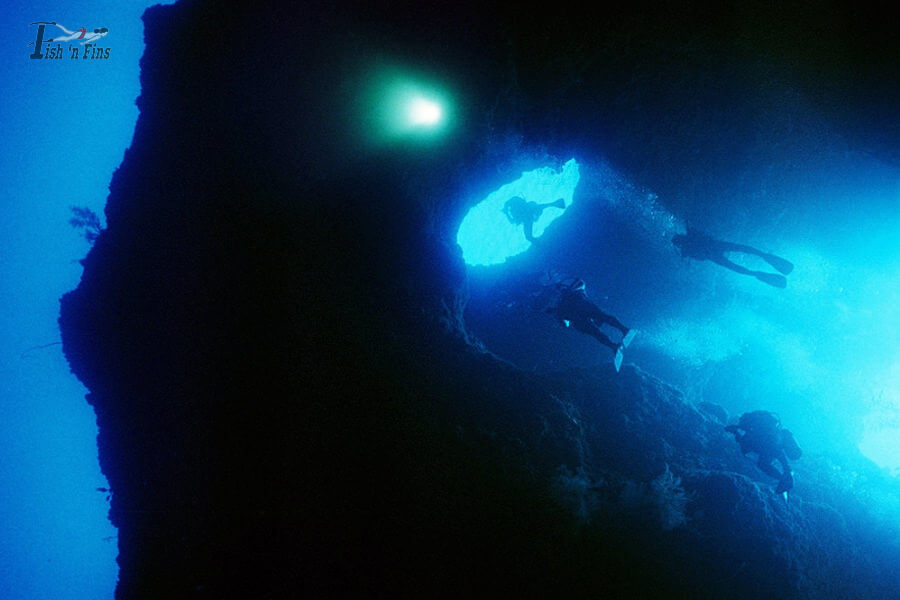
The Blue Holes dive site is situated northwest of Ngemelis Island and north of Blue Corner, lying 48 kilometres northwest of Koror. It can be reached by speedboat in 50-70 minutes.
This is an extremely popular spot, and the diving is ideal for novice and intermediate divers. Visibility tends to range from 45 to 120 feet (15 to 40 metres) and the currents are moderate to strong.
About the cavern
The Blue Holes dive spot is a popular way to start a dive to Blue Corner.
The reef is a vertical wall, running from north to south and merging with Ngemelis Wall at Blue Corner. Four holes in the reef form the entrance to a very large cavern, Blue Holes.
The holes open at a depth of 3-6 feet (1-2 metres), and there are two exits on the face of the reef. These exits are a 15-foot (five-metre) diameter window at 45-foot (15-metre), and a second 85-foot (27-metre) opening. The bottom of the cavern is at 120 feet (40 metres).
The Blue Holes is a very popular dive site, and as such there are usually dive boats circling. Safety. Safety Sausages should be used on ascent.
Currents
The currents here are usually moderate to strong, with down drafts. The currents change with the tides and reverse direction every six hours or so, bringing clean water, plankton and algae.
Divers swimming from Blue Holes to Blue Corner may have to swim against the current for about 150 feet (50 metres), though the currents here are unpredictable (and strong) during the half-moon.
Marine life
Inside the cavern, there are soft corals and Tubastraea on the walls, and various species of nudibranchs and shells on the bottom. Large schools of barracuda, tuna and snapper can be found patrolling the entrance. The vertical reef wall is rich with marine life, and home to just about every type of tropical fish and species of coral native to this region.
Once out of the cavern, divers can hook onto the reef and observe the sharks.
Diving
Blue Holes is second only to Blue Corner in terms of popularity with divers. A typical visit will begin with a swim over the shallow reef and into the cave through one of the four top holes. At low tide, divers move down along the wall and in through the small ‘window’.
The spacious cavern is usually flooded with light, with pale blue lights through the top holes and deep dark blue light through the large west side opening.
Be aware!
At the north end of the cavern is ‘The Temple of Doom’. This is a cave, entered at 85 feet. This spot is dangerous, and a number of divers have died here. Only those divers with a Cave Diver rating and special gear should enter, and only then with a professional guide.
FISH ‘N FINS – DIVE SITES – IRO
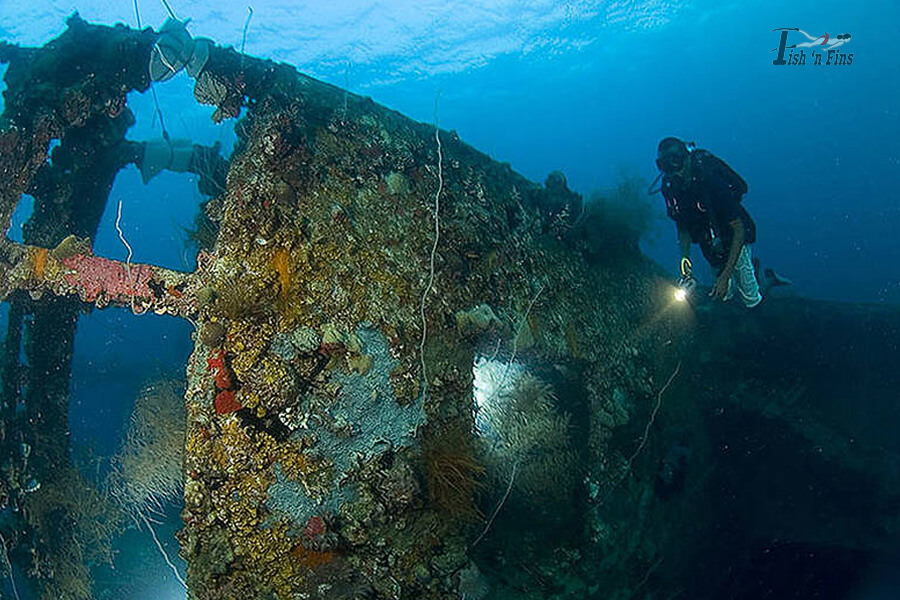
The final resting place of ‘Iro’ (or, Deutsche Beschreibung ganz unten) is Urukthapel Anchorage, southeast of Koror, just a 15-minute boat ride from most dive shops in Koror.
Visibility is inexplicably varied around the wreck site, shifting between 100 feet (30.4 metres) and 30 feet (10 metres) for no obvious reason. Visibility on the forward half of the wreck is usually much better than at the aft section, but again it is not clear why this is.
About the wreck and diving site
Built in 1922, this 470-foot fleet oiler and supply ship was on her way from Philippines to Palau when she came under attack by a US submarine. She sank on 30 March 1944, when a bomb launched during Operation Desecrate One caused a massive explosion in her engine room.
Her sister ship, Sata, sank just 300 yards away.
Today, the ship is standing upright at 120 feet (40 metres), the deck is at 85 feet (28 metres), and the top of the forward tower at 25 feet (8 metres).
Diving
This dive is for intermediate to advanced divers, and wreck experience is essential if you intend to enter the wreck. There are no currents here, but the dive requires careful monitoring of bottom time and air consumption.
Divers will typically begin by following the mooring line to the forward tower and onto the huge deck. On top of the east-pointing bow is a gun with a seven-inch (17.8 cm) barrel and 14-foot (4.26-metre) length, aiming down at a 20-degree angle. The gun is encrusted with corals.
The torpedo damage is visible at 80 feet (24.4 metres), with the hole now covered with black coral.
On the deck level, divers can explore the deck itself, fuel pipes, hoses hatches and portholes. The fire damage to the vessel has left the bridge open and easily accessible; and further down is the large engine room, with easily recognisable boiler. Follow the catwalks and railings to reach the stern, the loading tower and the aft gun.
The crew quarters can be located under the bridge. Divers should not attempt to go through here unless fully prepared to penetrate the ship.
There are no coral formations around the wreck, but various lagoon fishes can be seen.
Be aware!
It is not uncommon to find live ammunition at Palau’s wreck sites. Any bullets, bombs, mortars, etc., should be left exactly where they are! They are likely to be unstable and at risk of explosion.
FISH ‘N FINS – DIVE SITES – PELELIU WALL & CUT
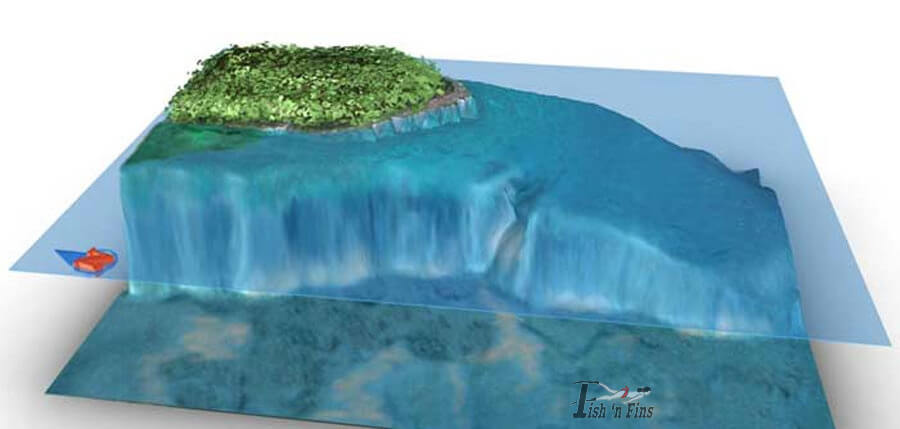
Peleliu Wall and Cut (or, Deutsche Beschreibung ganz unten) is located at the southern reef of Peleliu Island. It is 34 miles (55 kilometres) from Koror, accessible by speedboat in 55-70 minutes.
This is a difficult dive. There are extremely strong and unpredictable currents. At times of strong current, this dive is suitable for experienced divers only. Even in moderate currents, it is considered ‘advanced’. Safety Sausages are essential.
Visibility ranges from 75 to 150 feet (25 to 50 metres), depending on the direction of the tide. The total depth, from the reef to the plateau, is 30 to 90 feet (or, 10 to 30 metres).
Reef formation
Peleliu Cut is part of a vertical wall. This runs along the western side of Peleliu Island, extending to Peleliu Corner at the southern tip of the reef system. This section is the deepest reef structure in Palau.
Dropping from 30 feet (10 metres) in front of the WWII monument to 90 feet (30 metres), this is where the Peleliu Expressway and Peleliu Cut merge to create Peleliu Corner.
Marine life
Tropical fish can be found at the top of the plateau. These will include Pyramid Butterflyfish, Square Anthias, Moorish Idols, Sergeant Major’s, Yellowtail Fusiliers, Palette Surgeonfish, Bumphead Parrotfish and Purple Anthias. There are also bright yellow soft corals, long strands of cable corals, big bushes of black corals and sea fans on the wall.
Pelagic fish patrol the Cut and at the Corner, including Sperm Whales, Whale Sharks, Tiger Sharks, Bull Sharks, Orcas, Sailfish and Blue Marlin.
Diving
The boat will take you to the Peleliu Wall, which you will follow down to 80-90 feet (25-30 metres), possibly encountering counter currents.
At Peleliu Corner, you will need to stay deep. You can hook yourself onto the top of the reef and observe the stunning reef and marine life, including Gray Reef and White Tip sharks, and huge schools of surgeonfish, snappers and jacks.
The plateau gets deeper towards the south, and you will need to stay 15 to 20 feet (5 to 7 metres) above the reef to avoid down currents. When there is no current, divers can cut across the top of the plateau at 90 feet (30 metres). At this point, you can begin ascending.
Peleliu Island
Peleliu is a tranquil island of just 600 people, and home to some fascinating WWII sites.
Visitors to the southern tip of Peleliu Island will see a monument. This was erected by the Japanese after the war to honour soldiers on both sides of the conflict who gave their lives on the island.
A local guide can be hired for a guided tour of the historical sites. Tanzy Hesus comes most highly recommended. As the guardian of the local museum, he is extremely well informed and well regarded. The tours usually take 1-2 hours and can be enjoyed between dives.
FISH ‘N FINS – DIVE SITES – FAIRYLAND
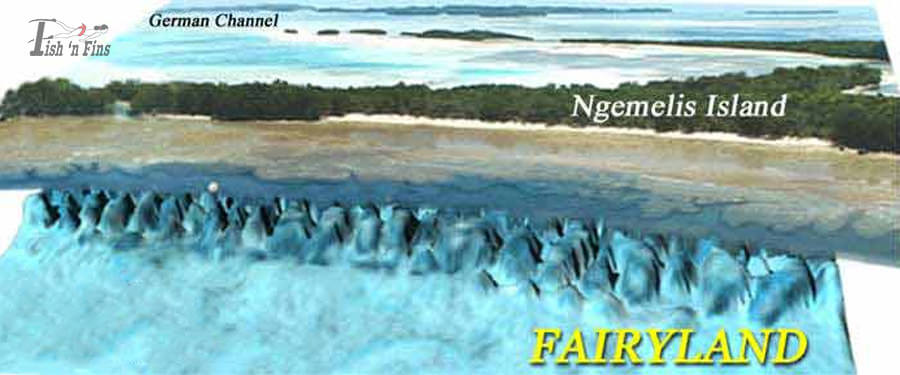
Fairyland (Ngemelis Coral Garden) is located west of Ngemelis Island and German Channel, about 28 miles (45 kilometres) southwest of Koror. It can be reached in 60-70 minutes by speedboat.
This is a beautiful spot with an easy dive, and home to a large variety of marine life – making it ideal for novice divers. The reef is 20 to 120 feet (7 to 40 metres) from top to bottom, and there is usually good visibility and no currents. An ideal location for a checkout or tune-up dive, divers routinely spend an hour at a time exploring the canyons and crevices.
Fairyland is a top spot for snorkelling, and dive boats often use this area for lunch break picnics. Due to the popularity of this spot, divers should use Safety Sausages when ascending to alert the many boat drivers to their position.
Reef formation and marine life
Fairyland is a part of the reef that spans the length of Ngemelis Island – the Ngemelis Reef system. Starting at the German Channel, it becomes the Big Drop Off and then Turtle Wall, and then New Drop Off. Just a mile north of New Drop Off, the reef becomes Fairyland.
Starting in just a few feet of water, the reef is fully exposed during low tide. The gentle coral slopes down to 60 feet (20 metres) and then becomes a run-off of broken coral and sand, with deep canyons and swim-throughs cutting through the slope.
The large variety of marine life here includes many types of tropical fish, including Butterfly fish, Triggerfish, Angelfish and wrasses. There are also Crocodile Fish and Cuttlefish.
FISH ‘N FINS – DIVE SITES – MANDARIN FISH LAKE
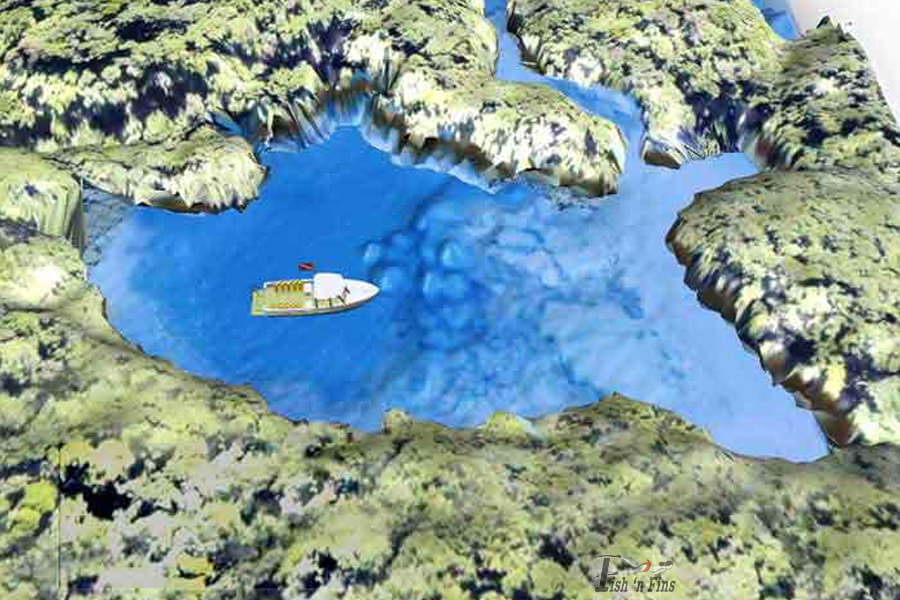
Mandarin Fish Lake is situated in Risong Bay, one mile (two kilometres) south of Koror, or just five minutes by speedboat.
A top spot for novice divers, the depth is just 3-24 feet (1-8 metres) and there are no currents. Visibility tends to be 15 to 40 feet (5 to 13 metres).
A secluded lagoon, Mandarin Fish Lake is tucked between several of the Rock Islands. In the middle of the cove, there are two large coral heads, with white sands at the bottom.
Only accessible by boat, the spot is particularly popular with snorkelers and divers, particularly those seeking stunning photo opportunities.
Mandarin Fish
Mandarin Fish (Synchiropus splendidus) reside at the sandy bottom of the lagoon, and they are probably the biggest draw for visitors. The fish are extremely beautiful and very shy, so patience is both necessary and rewarded in photographers!
The fish are seen only at dusk and on very cloudy days, and then just darting among the corals. They have a strong preference for still water and tend to hide among the rocks, their stunning colours contrasting beautifully with the white branches of the coral heads.
Other fish species and invertebrates can also be seen in the lagoon.
FISH ‘N FINS – DIVE SITES – ULONG CHANNEL
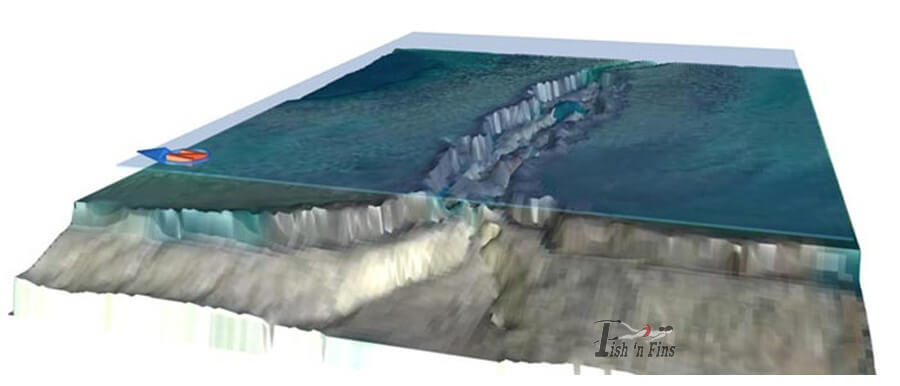
The Ulong Channel (Deutsche Beschreibung ganz unten), or the Ngerumekaol Pass, is located to the west of Ulong Island, or 15 miles (24 kilometres) west of Koror. It can be reached by speedboat in 30-40 minutes.
The reef is 10-40 feet (3 to 13 metres) from top to bottom. Visibility is strongest at incoming tide, when the current is strong and the water clear. In general, it ranges from 45 to 90 feet (15 to 30 metres).
Currents can be strong and unpredictable, changing abruptly, so the dive is best suited to advanced divers.
The Ulong Channel has beautiful beaches and picnic spots. Its stunning historical sites include the petroglyphs painted onto its high cliffs by Ancient Palauans.
Reef formation and marine life
The reef runs from west to east, cutting only partially through the western barrier reef. The sandy bottom of the channel is home to coral heads and coral formations, and plentiful marine life can be seen at the entrance.
These include Gray Reef Sharks, sting rays, schools of jacks, snappers, barracuda and batfish. During full moons in April, May, June and July, groupers gather here to spawn and have been seen to school.
Diving
A typical dive starts at the northern side of the Channel. Divers drop to 60 feet (20 metres), keeping the reef on their left, and approach the sandy run-off entrance to the Channel.
Sharks can be found here, in the strong currents.
Divers can hook onto one of the rocks here and take some time to observe the marine life.
Leaving this area, the powerful currents carry divers into the Channel, where there is an enormous section of lettuce coral growing from the bottom to a height of 15-20 feet (5-7 metres).
Be aware!
Titan Triggerfish use this area to nest. These extremely territorial fish are protective of their nest sites and can be aggressive with intruders. Divers should keep their distance to avoid being bitten!

